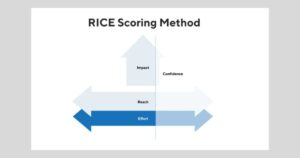Roadmap prioritization is the compass that guides product managers toward success in the ever-evolving landscape of product development. It’s an exciting journey with choices, challenges, and opportunities to shape remarkable products.
In this blog, we’ll explore four common approaches to roadmap prioritization and discover the practical tools and frameworks that can propel your product to new heights.
Quick note: While these are established approaches, there are more than these four methods. \
Method #1: Value vs Effort
We’ll start by exploring the value versus effort approach, which is widely embraced by product managers worldwide. It’s a powerful concept that enables us to strike a balance between delivering high value to customers and optimizing development efforts.
At its core, the value versus effort approach involves identifying initiatives that offer significant value to customers while requiring minimal effort during implementation. These are the low-hanging fruits—the initiatives that can make a remarkable impact without draining our team’s resources. Focusing on these initiatives can deliver exceptional outcomes that resonate with our customers and drive our business forward.
Balancing Challenges and Differentiation
While low-effort, high-value initiatives are highly desirable, we can’t overlook initiatives that offer significant value despite posing considerable challenges. These initiatives are situated in the upper right quadrant of the value versus effort graph. Though they may require more effort to implement, they have the potential to provide unique differentiating features that set our product apart from competitors.
As product managers, we must tackle challenging initiatives and maintain a competitive edge. While focusing solely on low-effort initiatives is tempting, neglecting the upper right quadrant can hinder our ability to stand out in the market. By including these initiatives in our roadmap, we can seize opportunities to innovate, create unique value propositions and cement our position as industry leaders.
Method #2: Weighted Scoring Model
When it comes to roadmap prioritization, the weighted scoring model emerges as a powerful ally for product managers. This approach allows us to assess initiatives based on their value, cost, and risk, providing a comprehensive framework for making informed decisions.
In the weighted scoring model, each initiative is assigned scores for various factors. The value score captures the potential impact and benefits the initiative can bring to our customers and the business. This score reflects how well the initiative aligns with our strategic goals and customer needs.
Additionally, the model incorporates cost considerations beyond development efforts. It encompasses ongoing support costs, the involvement of customer success teams, and the potential need for additional services or purchases.
Cost also incorporates the element of risk, which plays a crucial role in the decision-making process. By assessing the level of risk associated with each initiative, we can evaluate its feasibility and potential impact on our product and organization.
Incorporating Benefit Columns and Key Performance Indicators (KPIs)
To ensure a comprehensive evaluation, we can enhance the weighted scoring model by incorporating benefit columns and key performance indicators (KPIs). A benefit column allows us to focus on specific KPIs or North Star metrics most relevant to our product and business objectives. By aligning initiatives with these core metrics, we gain a clearer understanding of how each feature contributes to our overarching goals.
Method #3: The Kano Model
When prioritizing features for your product roadmap, the Kano model offers a unique and insightful approach. The model categorizes features based on their ability to deliver customer delight, providing a framework to create exceptional experiences and differentiate your product in the market.
The Kano model recognizes that not all features are created equal in terms of customer impact and satisfaction. Some features have the power to surprise and delight customers, exceeding their expectations and leaving a lasting impression.
These features go beyond functional requirements and elevate the overall user experience. By understanding and including features that delight your customer on your roadmap, you can create memorable moments.
The Kano model categorizes features into three main types: delight, performance, and essential features. Each type plays a distinct role in shaping the customer experience and contributing to your product’s success.

- Delight Features: These features aim to surprise and exceed customer expectations. Delight features are those unexpected aspects of your product that bring joy and satisfaction to users. Including these features on your roadmap is essential for creating memorable experiences and fostering customer loyalty. They differentiate your product and set it apart from competitors. As you invest in delight features, you deliver an inversely proportional increase in value to customers, making it a highly beneficial investment.
- Performance Features: These features focus on improving the overall performance and usability of your product. They enhance speed, efficiency, and responsiveness, resulting in a smoother and more enjoyable user experience. Performance features provide a linear increase in customer satisfaction. By consistently investing in these features, you can meet customer expectations and keep pace with evolving market standards. Enhancing performance aspects such as faster loading times or streamlined workflows directly contributes to customer value and satisfaction.
- Essential Features: These features serve as the foundation of your product, ensuring it remains competitive and meets basic user needs. These represent the minimum requirements for your product to stay in the game and fulfill customer expectations.
The model includes two other features worth noting.
- Indifferent Quality: These are features towards which customers are indifferent. Their presence or absence does not significantly impact customer satisfaction. An example might be the color of a power cable for a device.
- Reverse Quality: These features can lead to dissatisfaction if present and satisfaction if absent. Sometimes a feature that is assumed to be positive can be seen as negative by some users. For example, some people might find a constant app notification annoying and prefer not to have it.
Method #4: The RICE Model

When prioritizing features and initiatives for your product roadmap, the RICE scoring model has become a valuable tool for product managers. Introduced by the company Intercom, the RICE model provides a structured framework that helps evaluate and prioritize ideas based on their potential impact and feasibility.
The RICE model incorporates four key factors: Reach, Impact, Confidence, and Effort. Product managers can make informed decisions and allocate resources effectively by systematically considering these factors.
- Reach: The reach score in the RICE model represents the number of people, customers, or prospects an initiative will impact. It quantifies the potential audience or user base that the feature will reach. For example, if you have a thousand customers and a feature has the potential to impact 500 of them, the reach score would be 500. Evaluating reach helps gauge the scale of the impact a feature can have on your target audience.
- Impact: The impact score assesses the qualitative or quantitative effect that a feature will have on your customers. It measures the degree of positive change or value the feature will bring. The impact can be evaluated qualitatively by considering how exciting and impactful the feature will be for customers. Alternatively, it can be quantified by measuring specific metrics such as conversion rates, user engagement or revenue growth. By assessing impact, you can prioritize features that have the potential to make a significant difference to your customers and drive business outcomes.
- Confidence: The confidence score reflects the level of certainty or confidence you have in the success and impact of a feature. It incorporates development estimates, feasibility and alignment with your strategic goals. Confidence is subjective and relies on your intuition and assessment of various elements. A higher confidence score indicates a higher level of certainty that the feature will deliver as expected and meet the desired outcomes.
- Effort: The effort score represents the resources, time and effort required to develop and implement a feature. It considers factors such as development complexity, required team size and estimated timelines. Effort can be assessed using various methods, such as assigning high, medium, or low effort levels or using relative sizing techniques like t-shirt sizing. Understanding the effort in implementing a feature allows product managers to balance the expected impact with the available resources and make realistic prioritization decisions.
The RICE scoring model is highly customizable and adaptable to suit the specific needs and context of your company. While the core framework remains the same, you can tailor the model to incorporate additional factors or modify the weightage assigned to each component based on your unique requirements.
For instance, you can introduce additional criteria such as strategic alignment, customer feedback, or technical complexity to the model. By customizing the model, you ensure that it aligns closely with your company’s goals, priorities, and decision-making processes.
Furthermore, engaging stakeholders in the RICE scoring model can enhance its effectiveness. By involving key stakeholders, such as development teams, marketing, sales and customer support, you gain valuable insights and ensure a collaborative approach to prioritization.
Educating stakeholders about the RICE model and its methodology helps them understand the rationale behind your decisions and fosters a shared understanding of the prioritization process.
Differentiating Roadmap Prioritization from Backlog Prioritization
It’s important to differentiate between roadmap prioritization and backlog prioritization to ensure clarity. While both are essential components of product management, they operate on different levels and require distinct approaches.
Roadmap prioritization involves the strategic planning that shapes the overall direction of our product. It considers multiple factors, such as competitive differentiation, customer value and stakeholder needs. This macro-level approach enables us to select the right initiatives for our roadmap, aligning them with our product vision and strategic objectives.
On the other hand, backlog prioritization deals with the more granular aspects of development. Here, we work with a pre-existing list of stories, continuously assessing their value and development effort. Techniques like the Fibonacci sequence or story points help us assign values to individual stories and determine their priority. Backlog prioritization ensures that we optimize our team’s productivity and resources effectively, focusing on the immediate needs of development sprints.
By understanding the distinction between roadmap prioritization and backlog prioritization, we can approach each with the appropriate mindset and methodologies. This clarity empowers us to strike a harmonious balance between strategic planning and agile execution, propelling our product forward with purpose and efficiency.
Are you ready to take your product prioritization skills to the next level and drive success for your business?
Enroll in our Focus course at Pragmatic Institute and unlock the knowledge and expertise to evaluate, propose, and plan effective product strategies. Gain a deep understanding of market sizing, product portfolio management, and roadmap development.
By becoming a Pragmatic Certified Product Manager, you’ll have the credentials to showcase your mastery in strategic product management.
Author
-

The Pragmatic Editorial Team comprises a diverse team of writers, researchers, and subject matter experts. We are trained to share Pragmatic Institute’s insights and useful information to guide product, data, and design professionals on their career development journeys. Pragmatic Institute is the global leader in Product, Data, and Design training and certification programs for working professionals. Since 1993, we’ve issued over 250,000 product management and product marketing certifications to professionals at companies around the globe. For questions or inquiries, please contact [email protected].









